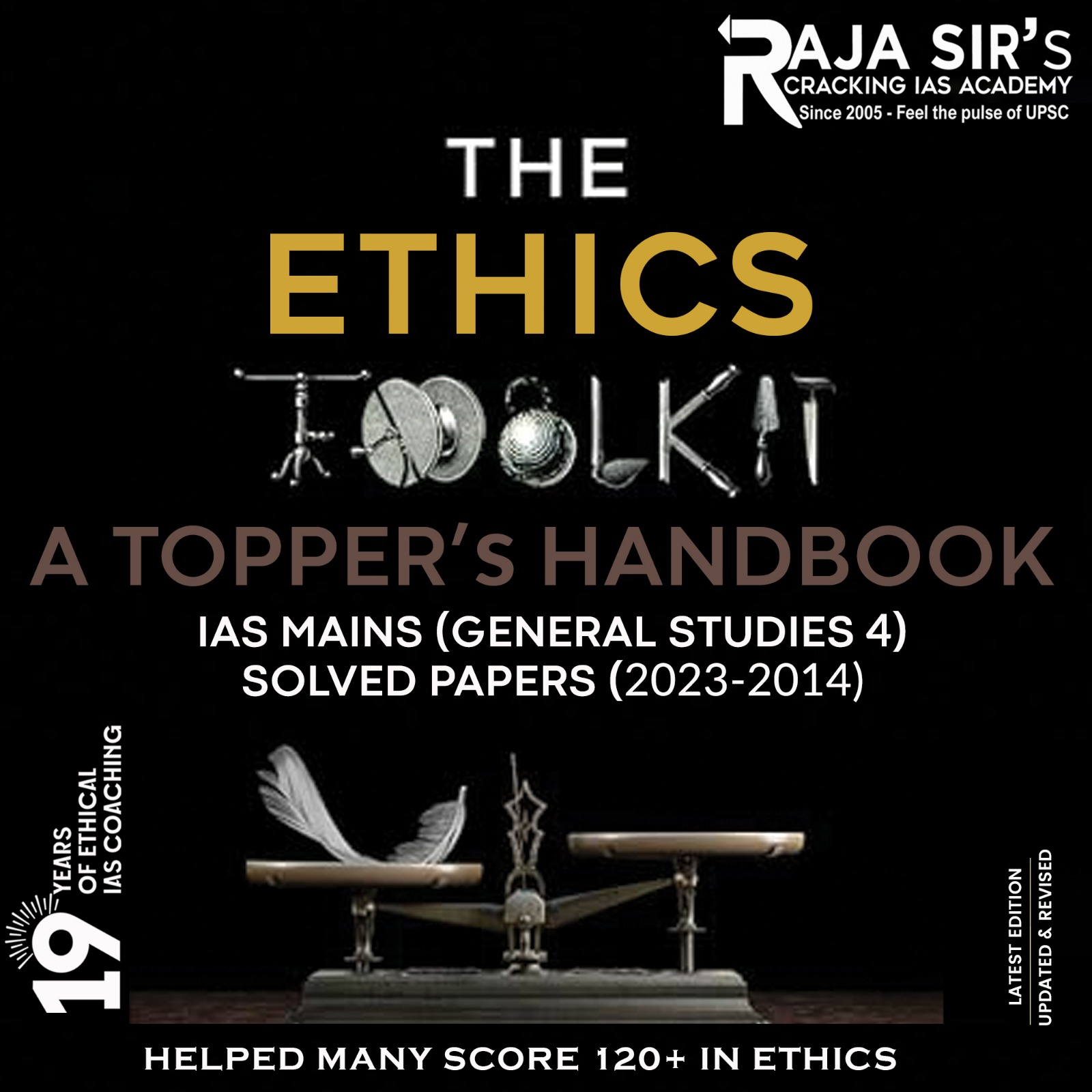- Home
- Prelims
- Mains
- Current Affairs
- Study Materials
- Test Series
 EDITORIALS & ARTICLES
EDITORIALS & ARTICLES
Hit List Questions 40 - PPP 100 PRELIMS 2024 - 58
Questions & Explanations:
|
1. |
1. It is designed in the Māru-Gurjara architecture of Nagara style. 2. Iron has not been used anywhere in the construction. 3. The temple has a total of 856 columns. Which of the statements given above is/are correct w.r.t. architecture of Ram Mandir Ayodhya? (a) 1 only (b) 2 and 3 only (c) 1 and 2 only (d) 1 and 3 only
|
|
||||||||||||
|
2. |
1. It is created in the earth’s atmosphere when cosmic rays slam into the atoms of the gases and release neutrons. 2. It readily combines with atmospheric oxygen to form radioactive carbon dioxide. 3. Its half-life is 12000 years. 4. Its concentration in the body is nearly constant and in equilibrium with its surroundings. The correct statements w.r.t. Carbon-14 are (a) 2, 3 and 4 only (b) 1, 2 and 4 only (c) 1, 3 and 4 only (d) 1, 2 and 3 only
|
|
||||||||||||
|
3. |
Consider the following statements: 1. Amarkantak Hills are at the confluence of Vindhya and Sahyadri Ranges 2. Biligirirangan Hills constitute the easternmost part of Satpura Range 3. Seshachalam Hills constitute the southernmost part of Western Ghats. How many of the statements given above are correct? (a) Only one b) Only two c) All three (d) None
|
|
||||||||||||
|
4. |
I. It is a Ramsar Site. II. It is essentially a network of creeks and canals. Which of the above statements is/are true w.r.t. Bhitarkanika national park? (a) Only I (b) Only II (c) Both I & II (d) Neither I nor II
|
|
||||||||||||
|
5. |
Which one of the following is not correctly matched? (a) Chang La - Jammu & Kashmir (b) Rohtang - Himachal Pradesh (c) Bomdi La - Arunachal Pradesh (d) Se La – Uttarakhand
|
|
||||||||||||
|
6. |
I. It is a minor tectonic plate. II. It is bound by four major tectonic plates. Which of the above statements is/are true w.r.t. Indian Tectonic Plate? (a) Only I (b) Only II (c) Both I & II (d) Neither I nor II
|
|
||||||||||||
|
7. |
The famous poem ''Go Get Education'' was penned by (a) Savitribai Phule (b) Pandit Ramabai (c) Sarala Devi (d) Sarojini Naidu
|
|
||||||||||||
|
8. |
1. Its members are elected by the United Nations Economic and Social Council. 2. India is currently a member of the Commission. Which of the statements given above is/are correct w.r.t. United Nations Statistical Commission? (a) 1 only (b) 2 only (c) Both 1 and 2 (d) Neither 1 nor 2
|
|
||||||||||||
|
9. |
Which one of the following east flowing rivers of India has a rift valley due to down warping?, (a) Damodar (b) Mahanadi (c) Sone (d) Yamuna
|
|
||||||||||||
|
10. |
1. Archean System contains the oldest rock formation of India. 2. The Gondwana deposits are laid down in synclinal troughs on ancient plateau surface. Which of the statements given above is/are correct w.r.t. Rock Systems of India? (a) 1 only (b) 2 only (c) Both 1 and 2 (d) Neither 1 nor 2
|
|
||||||||||||
|
11. |
Consider the following statements: 1. Assam shares border with Bhutan and Bangladesh. 2. West Bengal shares border with Bhutan and Nepal. 3. Mizoram shares border with Bangladesh and Myanmar. Which of the statements given above are correct? (a) 1, 2, and 3 (b) 1 and 2 only (c) 2 and 3 only (d) 1 and 3 only o |
|
||||||||||||
|
12. |
1. They seek refuge in deep burrows during daylight. 2. They are insectivores. 3. They are well adapted to desert regions. Which of the above statements is/are correct w.r.t. Indian Pangolin?. (a) 3 only (b) 2 and 3 only (c) 1 and 3 only (d) 1, 2 and 3
|
|
||||||||||||
|
13. |
Con sider the following rivers: 1. Kishenganga 2. Ganga 3. Wainganga 4. Penganga The correct sequence of these rivers when arranged in the north-south direction is (a) 1, 2, 3, 4 (b) 2, 1, 3, 4 (c) 2, 1, 4, 3 (d) 1, 2, 4, 3
|
|
||||||||||||
|
14. |
Where is Singchung Bugun Village Community Reserve? (a) Arunachal Pradesh (b) Manipur (c) Tripura (d) Nagaland
|
|
||||||||||||
|
15. |
With reference to the Himalayan range, which of the statements is/are correct? 1. The sedimentary rocks of the greater Himalayas were fossil less. 2. Marine livings fossils are found in the sedimentary rocks of lesser Himalayas. 3. Remains of human civilization are found in outer or Shivalik Himalayas. 4. Kashmir Himalayas has a landform known as ‘Karewa’. (a) 1, 3 and 4 only (b) 2, 3 and 4 only (c) 1 and 3 only (d) 1, 2 and 3 only
|
|
||||||||||||
|
16. |
The Tropic of Cancer passes through (a) Odisha (b) Jharkhand (c) Maharastra (d) All the above
|
|
||||||||||||
|
17. |
1. Zanskar Range 2. Dhauladhar Range 3. Ladakh Range 4. Karakoram Range The correct South to Northward sequence of the above relief features is (a) 2, 1, 3, 4 (b) 2, 3, 4, 1 (c) 4, 3, 2, 1 (d) 4, 2, 1, 3
|
|
||||||||||||
|
18. |
Assertion (A): Anticyclonic conditions are formed in the winter season when atmospheric pressure is high and air temperatures are low. Reason (R): Winter rainfall in northern India causes the development of anticyclonic conditions with low temperatures. (a) Both A and R are true and R is the correct explanation of A (b) Both A and R are true but R is not a correct explanation of A (c) A is true but R is false (d) A is false but R is true
|
|
||||||||||||
|
19. |
Match List I with List II and select the correct answer using the codes given below the lists.
(a) I-3, II-5, III-1, IV-4 (b) I-3, II-1, III-2, IV-5 (c) I-2, II-1, III-3, IV-4 (d) I-1, II-4, III-2, IV-5
|
|
||||||||||||
|
20. |
Consider the following statements. 1. Structurally, the Meghalaya plateau is an extended part of the Deccan plateau. 2. The Valley of Kashmir is a synclinal valley. 3. The Gangetic plain was formed in a fore deep. Which of these statements is/are correct? (a) 2 and 3 (b) 1 and 3 (c) 2 only (d) 1, 2 and 3
|
|
||||||||||||
|
21. |
I. Kolkata witnesses the longest day in the month of June. II. Chandigarh will have the longest daytime in comparison to Hyderabad. Which of the above statements is/are true? (a) Only I (b) Only II (c) Both I & II (d) Neither I nor II
|
|
||||||||||||
|
22. |
Which one of the following latitudes passes through maximum Indian states? (a) 20° N latitude (b) 22° N latitude (c) 24° N latitude (d) 26° N latitude
|
|
||||||||||||
|
23. |
I. It is the state animal of Kerala. II. Eravikulam National Park in Kerala has the highest density and largest surviving population of Nilgiri tahr. Which of the above statements is/are true w.r.t. Nilgiri tahr? (a) Only I (b) Only II (c) Both I & II (d) Neither I nor II
|
|
||||||||||||
|
24. |
Match List 1 with List 2
Codes (a) A-4; B-1; C-2; D-3 (b) A-2; B-3; C-5; D-1 (c) A-4; B-3; C-2; D-1 (d) A-2; B-1; C-5; D-3
|
|
||||||||||||
|
25. |
With reference to the National Financial Reporting Authority (NFRA), consider the following statements: 1. It is a statutory body constituted under the Companies Act, 2013. 2. It regulates the auditing profession and accounting standards in India. 3. Its members are appointed by an industry led consortium from private sector. How many of the statements given above are correct?. (a) Only one (b) Only two (c) All the three (d) None if these |
|
EXPLANATIONS
|
1. |
C |
|||||||||||
|
2. |
B |
|||||||||||
|
3. |
Amarkantak (NLK Amarakaṇṭaka) is a pilgrim town in Anuppur, Madhya Pradesh, India. The Amarkantak region is a unique natural heritage area and is the meeting point of the Vindhya and the Satpura Ranges, with the Maikal Hills being the fulcrum. The Billigirirangan hills, also known as Biligiriranga Hills or BR Hills, are not a part of the Satpura range. The Biligirirangana Hills or Biligirirangan Hills is a hill range situated in south-western Karnataka, at its border with Tamil Nadu (Erode District) in South India. The area is called Biligiri Ranganatha Swamy Temple Wildlife Sanctuary or simply BRT Wildlife Sanctuary. The Sesachalam hills, also known as Tirumala hills, are not a part of the Western Ghats. Seshachalam Hills are hilly ranges part of the Eastern Ghats in southern Andhra Pradesh state, in southeastern India. The Seshachalam hill ranges are predominantly present in Tirupati district of the Rayalaseema region in Andhra Pradesh, India. |
D |
||||||||||
|
4. |
https://iasgoogle.com/current_affair/january-19-2024-current-affairs Bhitarkanika National Park:
Saltwater crocodile:
|
C |
||||||||||
|
5. |
Nathu La Pass is located at an altitude of 14,140 feet and 53 kms from Gangtok, Sikkim.
|
A |
||||||||||
|
6. |
https://iasgoogle.com/current_affair/january-20-2024-current-affairs https://www.indiatoday.in/science/story/indian-tectonic-plate-is-breaking-into-two-its-happening-beneath-tibet-2489741-2024-01-17
|
A |
||||||||||
|
7. |
A |
|||||||||||
|
8. |
Recently, India started its four-year term as a member of the United Nations Statistical Commission.
|
C |
||||||||||
|
9. |
Damodar is a east flowing river with rift valley due to down warping. Down warp denotes a segment of the earth’s crust that is broadly bent downward. |
A |
||||||||||
|
10. |
As a geological unit, India comprises a series of rock systems belonging to different ages and periods. The rock system system of India has been classified under the following four categories: 1. Archaean Rock System 2. The Purana Rock System 3. The Dravidian Rock System 4. The Aryan Rock System Archaean Rock SystemIt refers to a rock system before the Cambrian system. They are considered the oldest rock system in the world. The further classification of the Archaean Rock System is as follows: 1. The Archaean System – Gneisses & Schists · Period of Formation: These are considered the oldest rocks, formed about 4 billion years ago at the time of the cooling and solidification of molten magma in the upper crust of the earth’s surface. · Features: o Azoic (unfossiliferous) o Crystalline (because of volcanic origin) o Foliated (consisting of thin sheets) o Extremely contorted and faulted o Often formed as plutonic intrusions (volcanic rocks found deep inside) · Major Rocks: o Gneiss: These cover two-thirds of peninsular India. Their mineral composition varies from granite to gabbro. They possess foliated or banded structures. o Schists: These are mostly crystalline. · Location: o Himalayas o Central and southern parts of the Peninsula o Orissa, Meghalaya, Madhya Pradesh, Chhattisgarh, and Chotanagpur Plateau of Jharkhand o Bundelkhand · Significance: These rocks consist of mineral resources like mica, talc, hornblende, chlorite, etc. 2. The Dharwar System This rock system derives its name from the rocks identified and studied in the Dharwar district of Karnataka. They are found in abundance in the Dharwar district of Karnataka. · Period of formation: o These rocks were formed and deposited in 3 major cycles, the period of which ranges from 3,100 million years ago to 1,000 million years ago. · Features: o They are the most ancient metamorphosed sedimentary rock system in the world formed due to the metamorphosis of sediments of Archaean gneisses and schists · Major Rocks: o Hornblede, Schists, Quartzites, Phyllites, Slates, Crystalline Limestones and Dolomites. · Location: o Dharwar-Bellary-Mysore belt of Karnataka o Jharkhand, Madhya Pradesh, Chhattisgarh, Odisha etc. o Himalayan region · Significance: These are the most important rocks in an economic sense as they possess valuable minerals like high-grade iron-ore, manganese, copper, lead, gold, etc. The Purana Rock SystemPeriod of Formation: These rocks were formed during the Proterozoic period (1400-600 million years ago). But, in the Indian context, the word Purana has been used instead of Proterozoic, so they are named the Purana Rock system. Features: These are sedimentary metamorphic formations and are unfossiliferous. Major Rocks: Clay, Slates, Sandstones, limestones, durable stones, etc. Location: The Cuddapah system is found in the Cuddapah and Kurnool districts of Andhra Pradesh. They are also found in the southern part of Chhattisgarh and along the main axis of the Aravalli range. The Vindhyan Rock system is found in a stretch extending between Sasaram and Rohtas in Bihar to Chittorgarh in Rajasthan. Significance: The Cuddapah Rock system has rich deposits of iron, manganese, copper, cobalt, nickel, etc. The Vindhyan Rock System has deposits of limestone, ornamental stones, and pure glass-making sand. Classification of Purana Rock System: This rock system is further subdivided into two systems – the Cuddapah System and the Vindhyan System. 1. Cuddapah System: · It is called the Cuddapah system because the rock outcrops were first observed in the Cuddapah district of Andhra Pradesh. · These were deposited in the synclinal basins. · These are unfossiliferous rocks. · Some of the rocks in this category are clay, slates, sandstones, and limestones. · These rocks contain ores of iron, manganese, copper, cobalt, nickel, etc. 2. Vindhyan System: · This rock system derives its name from the great Vindhyan mountains. · These are ancient sedimentary rocks superimposed on the Archaean base with a thickness of 4000 m thick. · These are mostly unfossiliferous devoid of any recognisable fossils. · They occupy an area of 1,00,000 sq. km. · They are found in Chhattisgarh, Karnataka, Andhra Pradesh etc. · Vindhayan system has diamond-bearing regions from which Panna and Golconda diamonds have been mined. They are devoid of any kind of metalliferous minerals but provide large quantities of durable stones, ornamental stones, limestone, pure glass-making sand, etc. The Dravidian Rock System (Palaeozoic) · Period of formation: 600-300 million years. · Features: The Dravidian period marked the onset of coal formation, particularly the high-quality Carboniferous coal. However, abundant deposits of these coals are not found in India. These are abundant in fossils and the beginning of coal can be seen in this period. · Major Rocks: Shales, sandstones, clays, quartzites, slates, salts, etc. · Location: These are found in the Extra Peninsular region and are rarely found in the Peninsular region. The regions of Anantnag of Kashmir, Spiti, Kangra & Shimla region of Himachal Pradesh, Handwara, Lider Valley, Gharwal & Kumayun of Uttarakhand, and Pir Panjal are the major regions of Dravidian rocks. · Significance: These include mineral resources like shale, sandstones, clays, quartzites, salts, talk, dolomite, marble, coal etc. · Classification of Dravidian Rock System: o The Cambrian Rocks: They are best developed in the northwest Himalayan region. o The Ordovician Rocks: These include quartzites, grits, sandstones, etc. o The Silurian Rocks: These are found in the Lahoul and Spiti Valley. They exist in the form of limes and shales. o The Devonian Rocks: These are devoid of any fossil fuel remains. o The Carboniferous Rocks: § The Carboniferous rocks formed around 350 million years ago comprise mainly limestone, shale, and quartzite. Carboniferous in geology means coal-bearing. It was during this period the coal formation started. The Aryan Rock System · Period of formation: Upper Carboniferous period to Recent. · Location: They are found in the Peninsular and Himalayan regions. · Classification of Aryan Rock System: o The Gondwana System: It derives its name from Gonds, the most primitive people of Telangana and Andhra Pradesh. § Period of formation: Permian period (250 million years ago). § Features: They are of continental origin, fluviatile, and lacustrine deposits laid down in synclinal troughs on ancient plateau surfaces. § Location: The locations of the Gondwana rock system are Damodar Valley in Jharkhand, Mahanadi River Valley in Chhattisgarh and Odisha, parts of Madhya Pradesh, etc. § Major Rocks: They have rich deposits of iron ore, copper, uranium, and antimony. Sandstones, slates, and conglomerates are used as building materials. § Significance: They are important as they contain nearly 98 percent of India’s coal reserves. o Jurassic System: These are named after the Jura mountains located on the borders of France and Switzerland. § Period of Formation: They were formed between 201.3 million to 145 million years ago. § Features: The marine transgression in the latter part of the Jurassic gave rise to a thick series of shallow water deposits in Rajasthan and Kuchchh. § Location: They overlay the Triassic system and cover wide areas in Tibet, South Ladakh, Spiti, Nepal, and Bhutan. § Major Rocks: Coral limestone, sandstone, conglomerates, and shales. § Significance: The rock strata laid down during the Jurassic Period have yielded gold, coal, petroleum, and other natural resources. · The Deccan Trap: o Period of formation: During the transition from the end of the Cretaceous to the beginning of the Eocene, an extensive volcanic upheaval occurred across Peninsular India that led to the formation of the Deccan Traps. The eruption resulted in the discharge of basaltic lava from fissures, covering an expansive region of approximately ten lakh square kilometers. o Features: These volcanic deposits are distinct with flat tops and steep sides. They have been named ‘traps’ derived from the Swedish term which means ‘ stair’ or ‘step.’ The processes of weathering and erosion have significantly diminished the size of the Deccan Traps, shaping the present geological landscape. o Major Rocks: The rocks in this region are of basalt type. The weathering of these rocks for a long time has given birth to black cotton soil known as ‘regur’. o Location: The current extent of the Deccan Trap spans approximately 5 lakh square kilometers, primarily distributed across regions such as Kuchchh, Saurashtra, Maharashtra, the Malwa plateau, and northern Karnataka. The Deccan Trap has been classified into the following groups: · The Upper Trap – Saurashtra and Maharashtra. · The Middle Trap – Malwa and Central India. · The Lower Trap – Central India and Tamil Nadu. · Significance: Regur which is black soil was formed due to the weathering of these rocks for a long time. It is an ideal soil type for cotton in the Penisnular region. · The Tertiary System: The Tertiary period holds immense geological significance as it marks an era during which the Himalayan mountain range came into existence. o Period of formation: 60 to 7 million years o Features: This period played a pivotal role in shaping India’s present geographical form. It is called the “Age of Mammals” because of the abundance of the fossil remains of these animals in the deposits of this period. o Major Rocks: The most significant rocks of this system may be found in India’s northern plains, in Kashmir’s karewas, and the Great Plains’ Bhangar, and Khadar. o Location: Their significant locations are in India’s northern plains, in Kashmir’s Karewas and the Great Plain. These are also found along the coasts of Kachchh, Kathiawar, Konkan, Malabar, Nilgiri, and the Eastern Ghats. o Significance: The rocks of this period have revealed a wealth of petroleum and coal deposits. · Shivalik System It takes its name from the Shiwalik hills between the Ganga and Yamuna rivers. Sandstones, grits, conglomerates, clays, and silts comprise the rock of this system. The Shiwalik system is famous for its oil resources, lignite, bauxite, and clays of different varieties. · The Pleistocene and Recent (Quartnery) Quaternary is a brief period of nearly one million years and is said to have started. It has two types – the older Pleistocene and the younger Recent. The fossiliferous clays, sands, and gravels of the Upper Satluj and the alluvial deposits in the river valleys of Tapi, Godavari, and Krishna belong to this age. The recent deposits in India are alluviums in the Indo-Gangetic region. These have been categorized as Bhangar and Khadar. |
C |
||||||||||
|
11. |
Assam is located in the north-eastern part of India. - In the North, it is bounded by the kingdom of Bhutan and state of Arunachal Pradesh. - To the East, it is bounded by the states of Nagaland and Manipur. - To the West it is bounded by Bangladesh and states of Meghalaya and West Bengal. West Bengal also shares its borders with three countries because of its narrow northward extension. Those countries are-Bangladesh to the East and Nepal and Bhutan in the North. Mizoram is a landlocked state in North East India whose southern part shares 722 kilometres long international borders with Myanmar and Bangladesh, and northern part share domestic borders with Manipur, Assam and Tripura.
|
A |
||||||||||
|
12. |
https://www.freepressjournal.in/bhopal/mp-wildlife-pangolin-conservation-project-succeeds-in-state Pangolins
Indian Pangolin:
|
D |
||||||||||
|
13. |
Kishenganga river is called the Neelam river in Jammu & Kashmir. Ganga river originates from the Gangotri glacier in Uttarakhand. Wainganga originates about 12 km from the Mundra village of Seoni district on the southern slopes of the Satpura range of Madhya Pradesh. Penang is a river found in the Yavatmal District of Maharashtra. |
A |
||||||||||
|
14. |
https://theprint.in/india/arunachals-bugun-community-reserve-home-to-endangered-species/1940165/ |
A |
||||||||||
|
15. |
Fossils from living marine creatures are found in the sedimentary rocks of the lesser Himalayas, which is true. Evidence of human civilization can be found in the outer or Shivalik Himalayas. The sedimentary rocks of the greater Himalayas do have fossils. Kashmir Himalayas has a landform known as ‘Karewa’. This consists of a series of plateaus that are above the Jhelum river and its branches. People who live there call it ‘Karewas’ or ‘Vuhr’. Bhabar is a narrow strip of flat land running next to the Himalayas in northern India. It is only 8-16 km wide and is covered with stones. The many streams that flow down from the hills have created beds with very high levels of porosity, so that all the streams disappear into the Bhabar. South of the Bhabar is the Tarai belt, which is 15-30 km wide and covered with marshy and swampy areas. This zone has lots of vegetation and is home to a variety of wildlife. |
B |
||||||||||
|
16. |
The Tropic of Cancer goes almost right through the middle of India. It goes through 8 Indian states, such as Mizoram, Tripura, West Bengal, Jharkhand, Chhattisgarh, Madhya Pradesh, Rajasthan and Gujarat. |
B |
||||||||||
|
17. |
|
A |
||||||||||
|
18. |
The winter rainfall in Northern India is locally known as Mahawat. Extratropical storms are worldwide marvels with dampness generally conveyed in the upper climate, dissimilar to their tropical partners where the dampness is conveyed in the lower environment. The chilly climate season starts from mid-November in northern India and remains till February. December and January are the coldest months in the northern piece of India. The temperature diminishes from the south toward the north. The normal temperature of Chennai, on the precipitation happens on the Tamil Nadu coast from these breezes as here they blow from ocean to land. In the northern piece of the nation, a weak high-pressure district creates, light breezes moving outwards from this region. Affected by the alleviation, these breezes blow through the Ganga valley from the west and the northwest. Clear sky, low temperatures, and low mugginess, and weak, variable breezes typically set the climate apart. During the winter season, the North-Western part of India gets rainfall from Western disturbances.
|
A |
||||||||||
|
19. |
I. Deccan Traps: These are large igneous provinces located on the Deccan Plateau of west-central India, which were formed during the Cretaceous-Eocene period, II. Western Ghats: The Western Ghats are a mountain range that covers an area of 160,000 square kilometres in a stretch of 1,600 kilometres parallel to the western coast of the Indian peninsula. They were formed during the Late Cenozoic period. III. Aravalli: The Aravalli Range is a range of mountains running approximately 692 km in a northeast direction across the Indian states of Gujarat, Rajasthan, and Haryana. It is considered part of the Pre-Cambrian period. IV. Narmada-Tapi: They are two rivers in Central India. The region between them is formed of sedimentary rock from the Pleistocene period. |
B |
||||||||||
|
20. |
Meghalaya Plateau
Pir Panjal Valley
Passes in Pir Panjal
Important Valleys
Strike valley vs. Transverse valley
The Indo-Gangetic Plains evolved as a consequence of filling up of a foredeep basin in front of the rising Siwalik Ranges. Earlier, the Siwalik foredeep had come into existence due to the flexing down of Indian plate following the collision of India with Asia. |
d |
||||||||||
|
21. |
Solstice is an astral event that occurs twice, once in the summer and once in the winter, year after year when the Sun reaches its highest point in the sky as seen at the North or South Pole. In summer the solstice day is the longest day of the year and in winter the solstice day is the shortest day of the year. June is Summer Solstice in the Northern hemisphere and Winter Solstice in South similarly; December is the Winter Solstice in the Northern hemisphere and the Summer Solstice in the Southern hemisphere. In other words, December Solstice is a winter season in the northern hemisphere and is the shortest day of the year while it is summer time in the southern hemisphere and the day longest of the year. To dodge any misunderstandings, Solstices are also known as June Solstice (Northern Solstice) and December Solstice (Southern Solstice). During the summer solstice, the day is longer and the nights shorter. The summer solstice falls during the June solstice in the northern hemisphere. Summer solstice occurs sometime between June 20 and June 22, depending on the movement of the calendar. In India, Kolkata witnesses the longest day in the month of June (Summer Solstice in the Northern Hemisphere).
|
C |
||||||||||
|
22. |
|
C |
||||||||||
|
23. |
Eravikulam National Park:
Key Facts about Nilgiri tahr:
|
B |
||||||||||
|
24. |
Bondla Wildlife Sanctuary - Goa Kangerghat National Park - Chhattisgarh Orang Sanctuary - Assam Ushkothi Wildlife Sanctuary - Orissa.
|
C |
||||||||||
|
25. |
National Financial Reporting Authority (NFRA):
|
B |









 Latest News
Latest News






 General Studies
General Studies